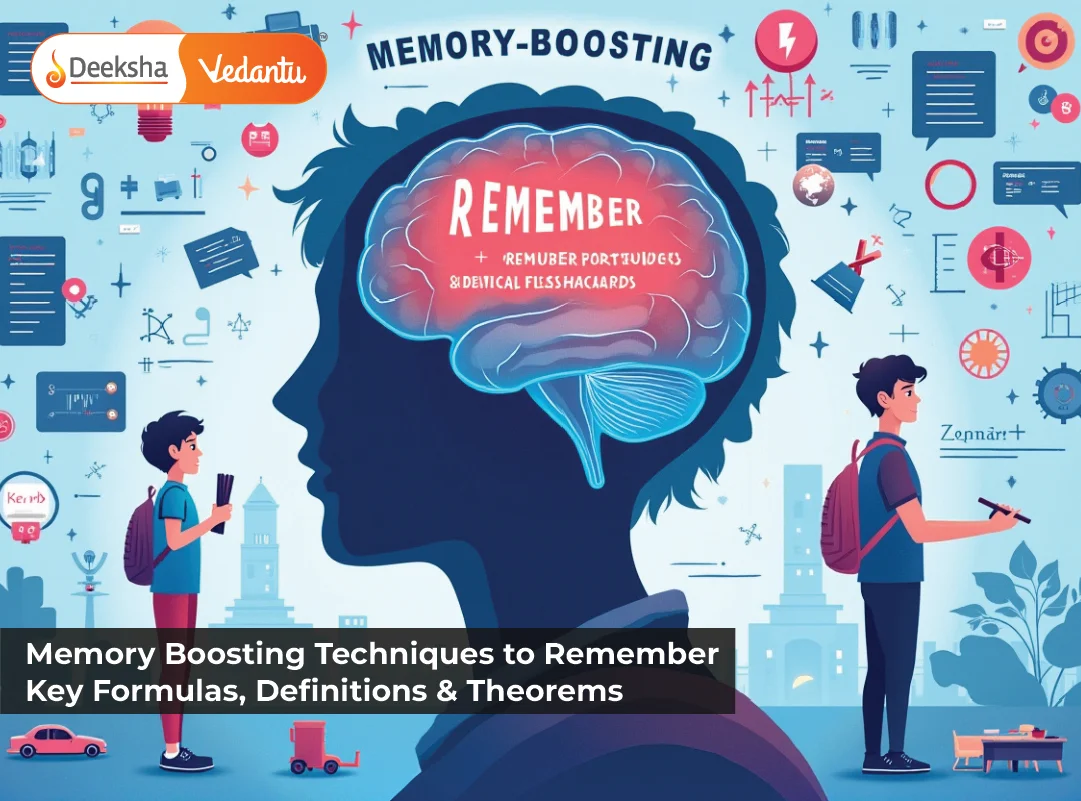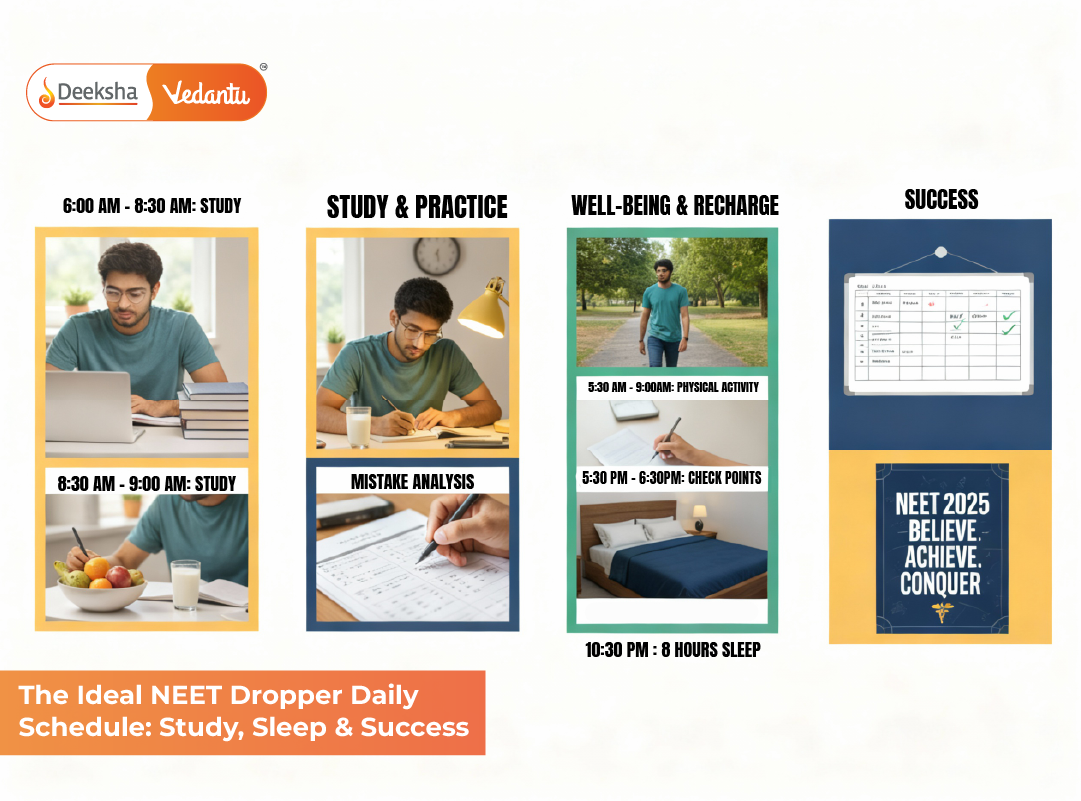Memorizing key formulas, definitions, and theorems is essential for subjects like Mathematics, Physics, Chemistry, and Biology. However, many students struggle with retaining and recalling these concepts during exams.
Common challenges students face include:
✔ Forgetting formulas under exam pressure.
✔ Confusing similar-looking equations or definitions.
✔ Cramming at the last minute and failing to retain information.
Instead of relying on rote memorization, students can use scientifically proven techniques to improve recall, strengthen memory retention, and reduce exam anxiety.
At Deeksha Vedantu, students are trained in effective memory strategies, ensuring they can memorize, retain, and recall information effortlessly during exams.
10 Memory-Boosting Techniques to Retain Formulas, Definitions & Theorems
Memorizing formulas, definitions, and theorems is an essential part of subjects like Mathematics, Physics, Chemistry, and Biology. However, traditional rote learning methods often fail to provide long-term retention. Instead, students can use scientifically backed memory-boosting techniques to recall key concepts efficiently during exams.
Read More: Top 10 Memory Improvement Tips For Scoring High
1. Mnemonics & Acronyms for Quick Recall
Mnemonics are memory aids that simplify complex information into easily memorable patterns. They use rhymes, acronyms, and abbreviations to help students recall formulas or sequences quickly.
Why It Works:
✔ The brain remembers patterns better than random information.
✔ Helps link abstract formulas to simple words or phrases.
✔ Reduces the burden of rote memorization.
Examples:
Example 1: Trigonometric Ratios (Math)
To remember Sine, Cosine, and Tangent, use the mnemonic:
SOH-CAH-TOA
- Sine = Opposite / Hypotenuse
- Cosine = Adjacent / Hypotenuse
- Tangent = Opposite / Adjacent
Example 2: Colors of the Rainbow (Physics)
To recall the seven colors of the rainbow:
VIBGYOR → Violet, Indigo, Blue, Green, Yellow, Orange, Red
Tip: Try creating your own mnemonics for difficult formulas to improve recall.
2. Mind Maps & Visual Learning
Mind maps help students organize information visually by connecting related concepts in a structured way. This technique improves comprehension and memory retention.
Why It Works:
✔ The brain processes images faster than text, making it easier to retain information.
✔ Helps students see relationships between formulas and concepts.
✔ A single visual representation is more effective than reading multiple pages.
Example:
Mind Map for Newton’s Laws of Motion (Physics)
- First Law (Inertia): Objects stay in motion unless acted upon by force.
2. Second Law (F=ma): Acceleration depends on force and mass.
3. Third Law (Action-Reaction): Every action has an equal and opposite reaction.
Tip: Draw diagrams and flowcharts to reinforce learning.
3. The Storytelling Technique
By converting formulas or concepts into engaging stories, students can retain them effortlessly.
Why It Works:
✔ Narratives are easier to recall than random facts.
✔ Creates mental associations that link theorems to everyday experiences.
✔ Makes abstract subjects like Physics and Chemistry more relatable.
Example:
Atomic Structure (Chemistry)
Imagine Bohr’s Model of the Atom as a solar system:
- The Nucleus (Sun) is at the center.
- Electrons (Planets) revolve around it in fixed orbits.
Tip: Make up funny or creative stories that link formulas to real-life situations.
4. Chunking & Grouping Related Information
Chunking breaks long formulas or definitions into smaller, manageable parts to make them easier to process.
Why It Works:
✔ The brain can only handle small pieces of information at a time.
✔ Grouping related formulas reduces mental overload.
✔ Helps students recall formulas in the correct order.
Example:
Quadratic Formula (Math)
Instead of memorizing x = (-b ± √(b² – 4ac)) / 2a as one long formula, break it down:
- b² – 4ac (Discriminant)
- Square root operation (√)
- Division by 2a
Tip: Look for patterns in formulas and group similar ones together.
5. The Feynman Technique – Teach to Learn
The Feynman Technique is a powerful learning method that involves explaining concepts in simple terms as if teaching a younger student.
Why It Works:
✔ Forces students to simplify complex ideas.
✔ Identifies gaps in understanding, making revision more effective.
✔ Helps with long-term retention by engaging in active learning.
How to Use It:
- Choose a formula or theorem.
2. Explain it as if teaching a 6-year-old—use simple words.
3. Identify gaps in understanding and re-learn the tricky parts.
4. Repeat until you can explain the formula clearly and confidently.
Example:
Pythagoras’ Theorem (Math)
Instead of memorizing a² + b² = c², explain it like this:
“If you make a right-angled triangle, the longest side (hypotenuse) is the sum of the squares of the other two sides.”
Tip: Teach your friends or pretend you’re explaining to an imaginary student to test your recall.
6. Spaced Repetition for Long-Term Retention
Spaced repetition is a scientifically proven memory technique where students review information at gradually increasing intervals instead of cramming.
Why It Works:
✔ Strengthens long-term memory by forcing the brain to recall information repeatedly.
✔ Prevents forgetting by reinforcing learning at optimal intervals.
✔ Improves exam preparedness by maintaining consistent revision.
Example:
Revision Schedule for a Theorem
Day 1: Learn the formula.
Day 2: Recall it without looking.
Day 4: Test yourself again.
Day 7: Use it in a practice question.
Day 14: Revise once more.
Tip: Use flashcards or apps like Anki and Quizlet to schedule spaced revision.
7. Memory Palace Technique
The Memory Palace method involves associating formulas with specific locations in your house or school.
Why It Works:
✔ The brain is wired to remember locations better than abstract information.
✔ Helps recall sequential or categorized information easily.
✔ Engages spatial memory to improve learning.
Example:
Laws of Thermodynamics (Physics)
- First Law = Written on your front door.
2. Second Law = Pinned on your study table.
3. Third Law = Written on the fridge.
Tip: Use familiar places (like your home, classroom, or favorite park) for maximum effectiveness.
8. Using Flashcards & Digital Apps
Flashcards are proven tools for quick memory recall and active learning.
Why It Works:
✔ Helps review information in short bursts, perfect for revision.
✔ Engages active recall, making retention stronger.
✔ Digital apps allow tracking of weak areas.
Example:
Chemistry Equations Flashcards
Front: H₂ + O₂ → ?
Back: H₂O (Water Formation Reaction)
Tip: Use digital flashcard apps like Anki, Brainscape, or Quizlet for interactive revision.
Read More: How Mobile Apps Help You Score Well
9. Active Recall & Self-Testing
Active recall involves forcing the brain to retrieve information rather than just reading passively.
How to Apply Active Recall:
- Write down a list of formulas you need to memorize.
2. Cover them up and recall them from memory.
3. Check for mistakes and correct them.
Tip: Instead of re-reading notes, test yourself regularly to improve retention.
10. Associating Formulas with Real-World Applications
Applying formulas to real-life situations strengthens memory and understanding.
Example:
Newton’s Laws of Motion (Physics) & Driving a Car
1. First Law: A parked car won’t move unless a force is applied.
2. Second Law: The heavier the car, the more force needed to accelerate.
3. Third Law: The tires push against the road, and the road pushes back.
Tip: Try to relate concepts to everyday experiences like driving, cooking, or sports.
Read More: What To Do & Not To Do During Revision Breaks
How Deeksha Vedantu Helps Students Master Formula Retention
At Deeksha Vedantu, students don’t just memorize formulas—they understand, apply, and retain them using structured learning techniques, personalized mentoring, and scientifically proven memory strategies. Here’s how Deeksha Vedantu ensures students excel in formula retention and application.
1. Smart Learning Strategies Tailored for SSLC & PU Students
✔ Deeksha Vedantu integrates visual learning methods like mind maps, diagrams, and flowcharts to make complex formulas easier to understand.
✔ Concept-based teaching helps students see the logic behind formulas, rather than memorizing blindly.
✔ Interactive classroom techniques, such as storytelling, discussions, and real-life applications, enhance retention.
🔹 Example:
Instead of just memorizing Ohm’s Law (V = IR), students at Deeksha Vedantu apply it to real-world circuits, making the concept easier to recall.
2. Practice-Oriented Coaching with Memory Hacks
✔ Deeksha Vedantu follows an active learning approach, where students regularly apply formulas in problem-solving exercises.
✔ Teachers use mnemonics, acronyms, and chunking techniques to help students break down complex definitions.
✔ Regular self-testing, quizzes, and flashcard-based learning ensure formulas are revised consistently.
🔹 Example:
For trigonometric identities, students learn through engaging challenges like “Formula Memory Battles” where they recall and apply identities quickly in a game format.
3. Personalized Study Plans for Formula Memorization & Exam Preparation
✔ Each student receives a customized revision plan, ensuring that formulas and theorems are revised at regular intervals using spaced repetition techniques.
✔ One-on-one mentoring sessions focus on helping students with challenging topics and weak areas.
✔ Doubt-solving sessions and peer learning encourage students to teach each other, reinforcing the Feynman technique.
🔹 Example:
For Physics formulas, students create personalized flashcards and explain the concepts to peers, strengthening long-term retention.
4. Real-World Application to Reinforce Learning
✔ Students perform experiments and simulations to see formulas in action, making abstract concepts easier to remember.
✔ Hands-on projects in Science & Math allow students to apply formulas practically, reinforcing their understanding.
✔ Regular application-based tests help students use formulas in different contexts, improving adaptability.
🔹 Example:
Instead of memorizing Newton’s Laws of Motion, students participate in real-world demonstrations using toy cars and inclined planes, making retention effortless.
By combining interactive learning methods, personalized study plans, and real-world applications, Deeksha Vedantu ensures students not only memorize but truly understand and retain key formulas, theorems, and definitions for long-term success.
FAQs
1. What is the fastest way to memorize formulas and theorems?
✔ Use Mnemonics & Acronyms: Create short phrases or rhymes to remember complex formulas.
✔ Apply the Feynman Technique: Teach the formula to a friend or yourself in simple words.
✔ Use Mind Maps & Diagrams: Visual representations help store information in the brain effectively.
✔ Practice Active Recall: Cover the formula and try to write it from memory multiple times.
🔹 Example: For the quadratic formula, instead of rote learning, break it down into smaller parts and recall it step by step.
2. How often should I revise key formulas to retain them better?
✔ Follow the Spaced Repetition technique: Review formulas at increasing intervals (Day 1, Day 3, Day 7, Day 14, etc.).
✔ Use flashcards and test yourself weekly to strengthen memory.
✔ Apply formulas in practice questions—the more you use them, the better you remember them.
🔹 Example: If you struggle with integration formulas, practice one formula every alternate day instead of trying to cram all at once.
3. Can I improve my memory for exams using simple daily techniques?
✔ Yes! Small changes in daily study habits can improve memory retention.
✔ Use storytelling methods to connect formulas with real-life applications.
✔ Exercise regularly and get proper sleep—both are proven to enhance memory.
✔ Write down formulas by hand instead of just reading them.
🔹 Example: If memorizing Boyle’s Law, relate it to how a balloon expands and contracts based on air pressure.
4. Do digital tools and apps really help with memorization?
✔ Yes! Apps like Quizlet, Anki, and Brainscape use spaced repetition and active recall techniques.
✔ Digital flashcards make revision interactive and faster.
✔ Mind mapping apps help create visual associations for complex concepts.
🔹 Example: Use an app to create a formula deck and quiz yourself every day.
5. How can Deeksha Vedantu’s methods improve my formula retention?
✔ Deeksha Vedantu integrates multiple learning strategies, including:
- Interactive classroom discussions to reinforce formulas.
- Personalized mentoring & doubt-solving sessions.
- Customized revision plans based on individual learning styles.
✔ Students at Deeksha Vedantu learn through practical applications, hands-on activities, and scientific memory techniques.
🔹 Example: Instead of memorizing formulas passively, Deeksha Vedantu students use peer-learning techniques to teach and test each other, reinforcing memory naturally.
Conclusion
Memorizing formulas, definitions, and theorems is a crucial skill for students preparing for board exams and competitive tests. However, rote learning is not the most effective method. Instead, using scientifically proven memory techniques can enhance retention, improve recall, and reduce exam stress.
✔ Techniques like mnemonics, mind maps, spaced repetition, and active recall help students store and retrieve information efficiently.
✔ Real-world applications, storytelling, and teaching others reinforce understanding and make learning more engaging.
✔ Digital tools like flashcards and self-quizzing apps further improve memory by promoting active engagement.
At Deeksha Vedantu, students are trained in smart learning strategies that go beyond memorization. By combining interactive learning, structured revision plans, and personalized mentoring, students can retain information effectively and apply it with confidence in exams.
Table of Contents










Get Social